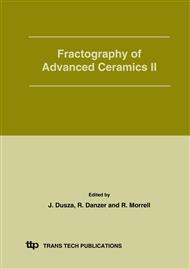p.332
p.336
p.340
p.344
p.348
p.353
p.358
p.366
p.370
The Preparation and Properties of Functionally Graded Alumina/Zirconia-Toughened Alumina (ZTA) Ceramics for Biomedical Applications
Abstract:
Functionally graded alumina/zirconia-toughened alumina (ZTA) ceramics for biomedical applications were designed with a hard, wear-resistant alumina surface and a tough, zirconia-rich core. The main goal was to achieve an improved mechanical performance by introducing a residual compressive stress in the outer surfaces. Symmetrical, 7-layered samples were prepared by the sequential slip-casting of specimens from suspensions prepared at the inherent pH values, close to the pH values at which the maximum (negative) zetapotential was measured. No sintering or tunneling cracks were observed in the samples, but large defects, such as big agglomerates, air bubbles and large circular pores at layer interfaces, which resulted from preparing the samples using the slip-casting technique, were readily observed. The strength of the symmetrical composites is influenced by the presence of defects, which most probably originate from the shaping process. Therefore, the defects have to be regarded as the reason why the strength of the 7-layered composites is low.
Info:
Periodical:
Pages:
348-352
Citation:
Online since:
July 2005
Keywords:
Price:
Сopyright:
© 2005 Trans Tech Publications Ltd. All Rights Reserved
Share:
Citation:


